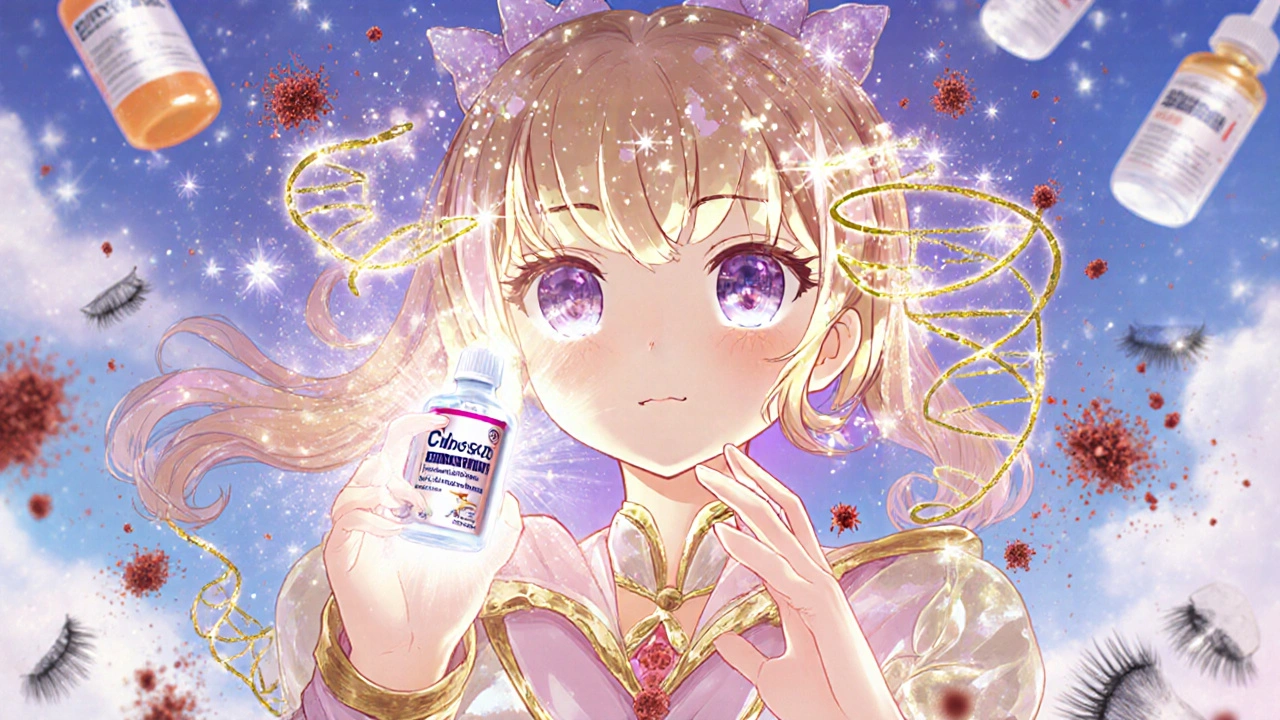Eye Infection Antibiotic Finder
Find Your Best Antibiotic Eye Drop
Answer these questions to get personalized recommendations based on your specific eye infection situation. This tool uses information from the article to help you understand which antibiotics might work best for your case.
1. What type of infection do you have?
2. Have you been using Ciloxan for more than 3 days with no improvement?
3. Do you have allergies to medications?
4. Are you wearing contact lenses?
5. What is your priority? (Select one)
When your eye turns red, feels gritty, or starts leaking pus, you don’t have time to wait. Eye infections move fast. Ciloxan (ciprofloxacin hydrochloride) is one of the most common prescriptions doctors reach for - but it’s not the only option. So how does it stack up against other antibiotic eye drops? And more importantly, which one actually works best for your situation?
What is Ciloxan, and how does it work?
Ciloxan is a 0.3% ophthalmic solution containing ciprofloxacin hydrochloride, a fluoroquinolone antibiotic. Also known as ciprofloxacin eye drops, it was approved by the FDA in 1993 and has since become a go-to for bacterial eye infections like conjunctivitis, corneal ulcers, and blepharitis.
It kills bacteria by blocking their ability to copy DNA - a mechanism that works fast. Most people notice improvement within 24 to 48 hours. The typical dose is one to two drops every two to four hours while awake for the first two days, then tapering off. It’s not for viral or fungal infections - only bacterial.
But here’s the catch: not all eye infections are the same. And not all antibiotics work the same way. Some infections are stubborn. Some patients are allergic. Others need something cheaper, gentler, or more targeted.
Top alternatives to Ciloxan
Doctors have several other antibiotic eye drop options, each with different strengths, side effects, and use cases. Here are the most common ones.
- Ofloxacin (Ocuflox) - Also a fluoroquinolone, similar to ciprofloxacin. It’s slightly less potent against some Gram-positive bacteria but works just as well for most common infections. Price-wise, it’s often cheaper than Ciloxan.
- Tobramycin (Tobrex) - An aminoglycoside antibiotic. Better for infections caused by Pseudomonas aeruginosa, a nasty bug often found in contact lens wearers. It’s not as broad-spectrum as ciprofloxacin but excels in specific cases.
- Levofloxacin (Quixin) - Another fluoroquinolone, but with stronger penetration into eye tissues. Often used for more severe corneal ulcers. More expensive, but sometimes necessary when Ciloxan fails.
- Moxifloxacin (Vigamox) - A newer-generation fluoroquinolone. Has a broader kill range, including some resistant strains. Often used in hospitals and after eye surgery. Comes in a preservative-free single-dose vial, which reduces irritation risk.
- Chloramphenicol - A low-cost, older antibiotic used widely outside the U.S. Effective against common bacteria but carries a rare risk of bone marrow suppression. Not FDA-approved for eye use in the U.S., but still prescribed off-label in some cases.
Side effects and safety: What to expect
All antibiotic eye drops can cause mild irritation - stinging, burning, or blurred vision right after application. That’s normal and usually lasts less than a minute.
Ciloxan has a slightly higher chance of causing a bitter taste in the mouth because the drops drain into the nasal passages. It can also cause eyelid swelling or itching in about 5% of users. Rarely, it triggers allergic reactions like hives or severe redness.
Tobramycin may cause more tearing and a gritty feeling. Moxifloxacin is often better tolerated - fewer reports of discomfort. Levofloxacin has a similar safety profile to Ciloxan but may cause more dryness.
Chloramphenicol is the riskiest. Though effective, the FDA warns against its use in the U.S. due to a 1 in 25,000 chance of life-threatening bone marrow damage. It’s not a first-line choice unless no other option exists.

When Ciloxan isn’t the best choice
Just because Ciloxan is common doesn’t mean it’s always right. Here’s when to consider switching:
- You’re a contact lens wearer with a severe infection - Pseudomonas is common here. Tobramycin or moxifloxacin may work faster.
- Your infection didn’t improve after 3 days - Ciloxan fails in about 10% of cases. Switching to levofloxacin or moxifloxacin often helps.
- You have a history of allergies - Some people react to the preservative benzalkonium chloride in Ciloxan. Preservative-free moxifloxacin is a better fit.
- You need something affordable - Ofloxacin is often half the price of Ciloxan and just as effective for mild cases.
- You’re treating a child - Some doctors prefer tomatin or erythromycin ointments for kids because drops are harder to administer and ciprofloxacin isn’t officially approved for children under 18 (though it’s often used off-label).
Cost comparison: What you’ll actually pay
Price matters - especially if you’re paying out of pocket. Here’s what you can expect in the U.S. as of 2025:
| Brand Name | Generic Name | Typical Cash Price | Insurance Copay | Preservative-Free? |
|---|---|---|---|---|
| Ciloxan | Ciprofloxacin hydrochloride | $120-$180 | $10-$30 | No |
| Ocuflox | Ofloxacin | $50-$90 | $5-$20 | No |
| Tobrex | Tobramycin | $70-$110 | $10-$25 | No |
| Quixin | Levofloxacin | $130-$190 | $15-$40 | No |
| Vigamox | Moxifloxacin | $150-$220 | $20-$50 | Yes (single-dose) |
| Chloramphenicol | Chloramphenicol | $20-$40 (imported) | N/A | No |
Generic versions of ciprofloxacin, ofloxacin, and tobramycin are widely available and can cut costs by 60-80%. If your insurance doesn’t cover the brand, ask for the generic. Many pharmacies sell ciprofloxacin eye drops for under $25 with a coupon.
Real-world use cases: Which drop for which problem?
Here’s how doctors actually choose between these options in practice:
- Mild pink eye with discharge - Ofloxacin or generic ciprofloxacin. Both work, and cost matters.
- Severe corneal ulcer - Moxifloxacin or levofloxacin. Deeper tissue penetration is critical.
- Post-surgery prevention - Moxifloxacin. Lower irritation, no preservatives, proven in clinical trials.
- Infected contact lens wearer - Tobramycin or moxifloxacin. Pseudomonas is the main threat.
- Child with conjunctivitis - Erythromycin ointment. Easier to apply, fewer side effects.
There’s no one-size-fits-all. The right choice depends on the bug, the severity, your history, and your budget.

What to do if Ciloxan doesn’t work
If your eye still hurts after 3 days of using Ciloxan as directed, don’t just keep using it. You could be masking a worse problem - like a fungal infection, herpes simplex virus, or even a foreign object stuck under your eyelid.
Go back to your doctor. They’ll likely:
- Check for signs of resistance
- Take a culture if the infection is severe
- Switch to a stronger antibiotic like moxifloxacin
- Consider adding steroid drops (only under strict supervision)
- Rule out non-bacterial causes
Self-treating beyond 3-5 days without improvement is risky. Delayed treatment can lead to permanent vision damage.
How to use eye drops correctly
Even the best antibiotic fails if you don’t use it right. Here’s how to get the most out of your drops:
- Wash your hands before touching your eye or the bottle.
- Tilt your head back, pull down your lower lid to form a pocket.
- Hold the dropper above your eye - don’t let it touch your eye or eyelashes.
- Squeeze one drop in. Close your eye gently for 30 seconds. Press the inner corner near your nose to prevent drainage.
- Wait 5 minutes between different drops.
- Don’t share bottles. Throw them away after 28 days, even if there’s liquid left.
Improper use is the #1 reason treatments fail.
Is Ciloxan better than Vigamox for eye infections?
Ciloxan and Vigamox (moxifloxacin) are both strong antibiotics, but Vigamox has broader coverage and is better for severe or post-surgical infections. Ciloxan works well for common bacterial conjunctivitis and is cheaper. Vigamox is preservative-free, which reduces irritation - making it better for sensitive eyes or long-term use. If Ciloxan didn’t work, Vigamox is often the next step.
Can I use Ciloxan for pink eye caused by allergies?
No. Ciloxan only treats bacterial infections. Allergic pink eye causes itching, watery eyes, and swelling - not pus. Antibiotics won’t help. You need antihistamine drops like ketotifen or cold compresses. Using Ciloxan unnecessarily increases your risk of antibiotic resistance.
Are generic ciprofloxacin eye drops as good as Ciloxan?
Yes. Generic ciprofloxacin hydrochloride has the same active ingredient, concentration, and effectiveness as Ciloxan. The FDA requires generics to meet the same standards. The only differences are in inactive ingredients or packaging - and those rarely affect performance. Most doctors prescribe the generic to save money.
How long should I use antibiotic eye drops?
Typically 7 to 10 days, even if your eye feels better after 2 or 3 days. Stopping early can let surviving bacteria come back stronger - and resistant to the drug. Always finish the full course unless your doctor says otherwise. Never save leftover drops for next time.
Can I wear contact lenses while using Ciloxan?
No. You should stop wearing contacts until the infection clears and your eye feels completely normal. Contacts trap bacteria and irritants against your cornea, slowing healing. Even after symptoms disappear, wait at least 24 hours after your last dose before reinserting lenses. Clean your case thoroughly - or replace it.
What happens if I accidentally swallow Ciloxan eye drops?
Swallowing a few drops won’t cause serious harm. The amount is tiny. But you might taste it strongly and feel a bit nauseous. If you swallow a full dropper or more, contact poison control. Fluoroquinolones like ciprofloxacin can cause side effects like tendon pain or nerve issues if taken orally in large doses - but eye drops are not meant to be ingested.
Final advice: Trust your doctor, but ask questions
Ciloxan is a solid, reliable option for many bacterial eye infections. But it’s not magic. It doesn’t work for everything. And it’s not always the cheapest or safest choice.
If your doctor prescribes Ciloxan, that’s fine. But ask: "Is this the best option for my type of infection? Are there cheaper or gentler alternatives? What if it doesn’t work?"
Eye health is too important to guess. Use the right tool for the job - and don’t settle for the first name you hear.






Comments
Dana Dolan
November 20, 2025 AT 16:43 PMJust had a nasty bacterial conjunctivitis last month - Ciloxan worked like a charm. Didn’t even need to go back to the doc. But man, that bitter taste in my mouth? Brutal. Like swallowing a metallic penny. Glad I didn’t have to deal with the preservative-free stuff - my insurance wouldn’t cover it.
Pro tip: always close your eye and press the tear duct after dropping. Learned that the hard way after wasting half a bottle.
Also, don’t touch the dropper to your eye. I did it once. Felt like a science experiment gone wrong.
Paige Lund
November 22, 2025 AT 15:50 PMSo Ciloxan’s the ‘go-to’… because it’s the one the pharma rep left samples of. Classic.
Reema Al-Zaheri
November 23, 2025 AT 08:29 AMIt is critical to understand that fluoroquinolones, including ciprofloxacin, are not universally effective against all bacterial strains; resistance patterns vary significantly by region and clinical setting. Furthermore, the use of non-preservative-free formulations may exacerbate ocular surface disease in patients with pre-existing dry eye syndrome. The data supporting moxifloxacin’s tissue penetration is robust, particularly in postoperative prophylaxis, and should be prioritized in high-risk populations.
Additionally, chloramphenicol’s risk of aplastic anemia, while rare, is not negligible; its off-label use in the U.S. remains medically contentious and ethically questionable in light of safer alternatives.
Michael Salmon
November 23, 2025 AT 22:16 PMOf course Ciloxan’s the ‘gold standard’ - because Big Pharma paid for the studies. Meanwhile, Tobrex is cheaper, more targeted, and doesn’t make your tongue feel like it’s been dipped in battery acid. But nope, we’re gonna keep prescribing the most expensive option because that’s how the system works.
And don’t even get me started on the ‘generic is just as good’ myth. Ever tried a 20-dollar generic that burns like hell and leaves residue? Yeah. Me too. It’s not the same. The inactive ingredients matter more than they let on.
Joe Durham
November 25, 2025 AT 20:42 PMI appreciate how thorough this breakdown is. Really helps cut through the noise.
I’ve had two eye infections in the last year - first one, Ciloxan worked fine. Second one? Didn’t touch it. Went back, got moxifloxacin, and it cleared up in 48 hours. No bitterness, no irritation. I think the key is listening to your body. If it’s not working after 48 hours, don’t just push through - that’s when things get dangerous.
Also, the contact lens warning? 100% true. I ignored it once. Regretted it for weeks.
Derron Vanderpoel
November 27, 2025 AT 15:37 PMMY EYE WAS SO RED I COULDNT SEE MY OWN FACE IN THE MIRROR AND I WAS SCARED I WAS GOING BLIND AND THEN I USED CILOXAN AND IT WAS LIKE A MIRACLE BUT THEN I TASTED IT AND I THOUGHT I WAS DYING FROM THE METALLIC TASTE AND I CRIED AND THEN I THOUGHT I WAS GOING TO THROW UP AND THEN I REALIZED I WAS JUST FINE AND I COULD SEE AGAIN AND I HUGGED MY DOG AND I FELT LIKE A NEW PERSON
ALSO I THINK MOXIFLOXACIN IS THE REAL MVP. PRESERVATIVE-FREE? YES PLEASE. I’M A SENSITIVE EYE PERSON AND I’M HERE FOR IT.
Timothy Reed
November 29, 2025 AT 06:34 AMExcellent summary. The cost comparison table is particularly valuable for patients navigating out-of-pocket expenses.
One point worth emphasizing: even when generics are available, pharmacy supply chains can vary significantly in quality control. I’ve seen cases where a patient received a generic ciprofloxacin formulation with inconsistent pH levels, leading to prolonged irritation. Always check expiration dates and storage conditions - especially if purchasing from discount retailers or international suppliers.
Also, for pediatric cases, the ointment formulation is often more practical than drops. Compliance is higher, and the risk of accidental ingestion is lower.
Christopher K
November 29, 2025 AT 10:18 AMChloramphenicol? Imported? From where? India? China? You’re telling me we’re letting people use Russian-made eye drops that could kill their bone marrow? This is why America’s healthcare is a mess - we’re letting foreign junk in because ‘it’s cheaper.’
Meanwhile, Vigamox is made right here in the USA with FDA-approved standards - and you’re gonna tell me to use a 20-dollar bottle from some sketchy online pharmacy? No thanks. I’d rather pay $200 and know I’m not risking my life for a few bucks.
harenee hanapi
November 29, 2025 AT 14:49 PMUgh I HATE WHEN PEOPLE SAY CILOXAN IS FINE. I USED IT AND MY EYE GOT WORSE AND I WAS SO SAD AND I FELT LIKE NO ONE LISTENED TO ME AND NOW I’M AFRAID TO EVEN LOOK AT MY MIRROR BECAUSE I THINK I’M GOING BLIND AGAIN AND I JUST WANT SOMEONE TO UNDERSTAND HOW SCARY IT WAS WHEN I COULDN’T SEE AND THE DOCTOR JUST SAID ‘KEEP USING IT’ AND I DID AND IT GOT WORSE AND THEN I HAD TO GO TO THE ER AND THEY SAID IT WASN’T EVEN BACTERIAL AND I WAS ON ANTIBIOTICS FOR NOTHING AND NOW I’M TRAUMATIZED AND I DON’T TRUST DOCTORS AND I’M JUST SO TIRED OF BEING IGNORED.
WHY DOESN’T ANYONE TALK ABOUT THIS?!
Christopher Robinson
November 29, 2025 AT 20:08 PMBig fan of the moxifloxacin preservative-free single-dose vials - no irritation, no waste, no drama 🙌
Also, if you’re using eye drops and still wearing contacts? Please stop. I know it’s annoying, but your lenses are basically bacterial hotels. Replace the case, too. I use a UV sanitizer now - life changer.
And yes, generics are legit. I’ve used generic cipro for years. Same active ingredient. Just cheaper. Save your cash for something fun, like coffee. ☕
seamus moginie
November 30, 2025 AT 15:37 PMRight then, I’m from Dublin and we’ve got a bloke here who swears by chloramphenicol - bought it off a mate who got it from a pharmacy in Poland. Says it worked better than anything else. I don’t know if it’s safe, but he’s still got both eyes. So maybe? 🤷♂️
Still, I’d go with the generic cipro. Cheaper than a pint and just as good. Just don’t touch the dropper to your eye - I did that once and nearly lost my eyebrow from the panic.
Zac Gray
December 1, 2025 AT 04:02 AMLet’s be real - the real reason Ciloxan is prescribed so often isn’t because it’s the best, it’s because it’s the most familiar. Doctors are trained on it, pharmacists stock it, insurance forms have it pre-checked. It’s inertia dressed up as medicine.
But here’s the thing: when you’ve got a patient who’s been on three different antibiotics already and nothing’s worked, you don’t reach for the same bottle again. You go deeper. You culture. You ask questions. You consider fungal causes. You don’t just double down on a fluoroquinolone because it’s the default.
And if your doctor doesn’t do that? Find a new one. Your vision isn’t a default setting.
Steve and Charlie Maidment
December 2, 2025 AT 03:11 AMWhy do we even have this many options? It’s ridiculous. Why can’t there just be one eye drop that works for everything? Like a magic bullet? Why do we need to know the difference between Gram-positive and Gram-negative? I just want my eye to stop burning.
Also, who decided that 5 mL bottles should last 28 days? That’s 140 drops. I use maybe 10. The rest just sits there gathering dust and bacteria. Why not make them 1 mL? Or single-use? This system is broken.
Michael Petesch
December 3, 2025 AT 12:19 PMIn India, chloramphenicol is routinely used as a first-line treatment for conjunctivitis, even in children, due to its low cost and broad efficacy. While the risk of aplastic anemia is statistically small, the cultural and economic context makes its use pragmatic. In the U.S., where healthcare costs are high and litigation is common, the preference for newer, branded agents is less about clinical superiority and more about risk mitigation.
It’s not that one system is ‘right’ - it’s that each reflects its societal priorities.
Ellen Calnan
December 4, 2025 AT 05:30 AMThere’s something deeply human about how we treat our eyes - we guard them like sacred things. We don’t let strangers touch them. We cry when they hurt. We stare into mirrors for hours, terrified of what we might see.
And yet, we treat antibiotics like they’re candy - pop a drop, wait a day, if it doesn’t work, try another. We forget that our bodies are ecosystems, not machines.
Ciloxan isn’t the hero. It’s a tool. And like any tool, it’s only as good as the hand that uses it - and the mind that knows when to stop.
Maybe the real question isn’t which drop works best…
But who’s listening when we say we’re still in pain?